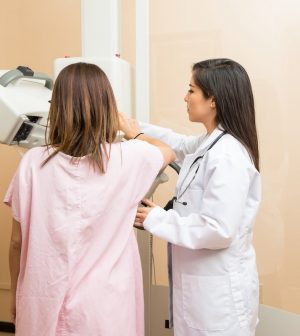- Navigating Your Midlife Crisis: Embracing New Possibilities
- City Raccoons Showing Signs of Domestication
- Mapping the Exposome: Science Broadens Focus to Environmental Disease Triggers
- One Week Less on Social Media Linked to Better Mental Health
- Your Brain Changes in Stages as You Age, Study Finds
- Some Suicide Victims Show No Typical Warning Signs, Study Finds
- ByHeart Formula Faces Lawsuits After Babies Sickened With Botulism
- Switch to Vegan Diet Could Cut Your Greenhouse Gas Emissions in Half
- Regular Bedtime Does Wonders for Blood Pressure
- Dining Alone Could Mean Worse Nutrition for Seniors
Study Supports Annual Mammograms for Women Over 40

A new study supports the notion that women age 40 and older get a mammogram each year rather than every two years, to help catch breast cancers early.
The rate at which mammograms revealed a tumor in its later stages was significantly lower among women who got an annual mammogram versus those who spaced the scans out over two or more years, reported a team at the University of Pittsburgh.
“Annual mammograms are crucial for early detection of breast cancer, which increases the likelihood of survival, decreases harms to patients because treatment may not need to be as intense, makes recovery easier and can lower the cost of care,” said study lead author Dr. Margarita Zuley, a professor of radiology at Pitt.
The new findings come in the context of dueling guidelines around the recommended frequency of mammograms, which can be confusing for many women in their 40s.
Guidelines from the American College of Radiology advise that women over 40 get a mammogram once every year, whereas guidelines from the influential U.S. Preventive Services Task Force recommends mammograms once every two years, beginning at age 40.
In the new study, Zuley’s group drew on a large institutional database that included more than 8,100 women who’d undergone at least one mammogram prior to a breast cancer diagnosis.
Reporting recently in the Journal of Clinical Oncology, Zuley and colleagues found the percentage of breast cancer patients who were diagnosed with a late-stage cancer (stage IIB or worse) rose along with the time interval between mammograms.
A total of 9% of women who got annual screens had a late stage cancer, compared to 14% of those who got a mammograms once every two years and 19% of those who got screened “intermittently” (at least a 27-month interval between scans).
Of course, getting a mammogram more often does increase the odds that a woman might be given a false-positive result, which could prompt unnecessary worry and medical procedures.
“We recognize that there are potential harms associated with calling women back for additional screening, but I don’t think that these harms outweigh the risk of missing cancers and women dying as a result,” Zuley said in a university news release. She’s also chief of the Division of Breast Imaging at the University of Pittsburgh Medical Center.
“We’re also working on testing screening tools that have lower false positives than mammography and pushing on every front to identify the most cost-effective and accurate way of taking care of our patients,” she added.
More information
The American Cancer Society has its own breast cancer screening guidelines.
SOURCE: University of Pittsburgh, news release, Aug. 26, 2024
Source: HealthDay
Copyright © 2025 HealthDay. All rights reserved.










